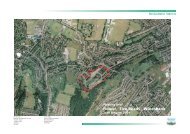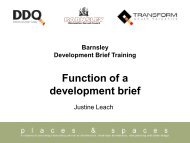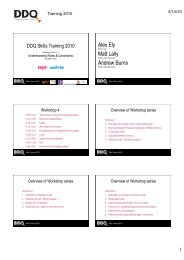Handbook: Workshop 1 (PDF) - DDQ - Delivering Design Quality
Handbook: Workshop 1 (PDF) - DDQ - Delivering Design Quality
Handbook: Workshop 1 (PDF) - DDQ - Delivering Design Quality
Create successful ePaper yourself
Turn your PDF publications into a flip-book with our unique Google optimized e-Paper software.
Preparation and Setting OutThe key to good site analysis is to gain an understandingof the context. Then once the context is understood fully,the site is seen in its context. The context analysis is morethan that just beyond the site boundary. On all projects adesigner will:• Reflect on the planning context of the site• Review mapping and plans for the site• Observe surrounding features influencing the siteAn example is to check what is within a reasonable walkingdistance from the site. This could include destinationssuch as:• Public transport routes, bus stops and stations• Open spaces and recreation spaces• Schools• Shops• Community facilities• Land form and water coursesThe site is then analysed to see how it fits the context. Sitefeatures that are useful to study are:• Role of site/context – such as identifying the uses thatwould most suit the locality• Edges – how the site is enclosed or integrated into itssetting• Movement and Access – what are the possibilities forintegration• Townscape – character sensitivities• Open space distribution – is there a lack of or sufficientamenity space• Land use pattern – how mixed or segregated uses aredistributed• Form and Massing – the height and depth of existingbuildings• Solar orientation – how best can this be exploited<strong>DDQ</strong> training 2010 workbook15






